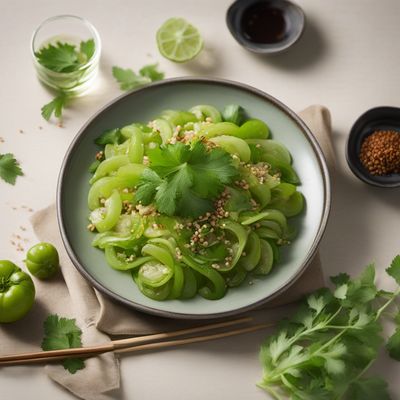
Cuisine
Japanese Chinese cuisine
Japanese Chinese cuisine is a blend of Chinese and Japanese ingredients and cooking techniques. It is characterized by its delicate and subtle flavors, use of seafood, and incorporation of local ingredients. The cuisine is a result of the Chinese immigrants who settled in Japan and adapted their cuisine to the local ingredients and flavors. Japanese Chinese cuisine is a popular cuisine in Japan and is enjoyed by locals and tourists alike.
Typical ingredients
Soy sauce, Vinegar, Garlic, Ginger, Onions, Sake, Mirin, Dashi, Seafood, Noodles, Rice, Vegetables, Fruits
Presentation and garnishing
Japanese Chinese dishes are often served family-style, with several dishes served at once. The dishes are often garnished with fresh herbs and vegetables, such as cilantro and scallions. The presentation of the dishes is important, as it adds to the overall dining experience.
The most popular dishes in Japanese Chinese cuisine include gyoza, chahan, and ramen.
More cuisines from this region...
Singaporean Chinese cuisine, Malaysian Chinese cuisine, American Chinese cuisine, Australian Chinese cuisine, Canadian Chinese cuisine, Peranakan cuisine, Korean Chinese cuisine, Chinese Indonesian cuisine, Filipino Chinese cuisine, Indian Chinese cuisine
History
The history of Japanese Chinese cuisine dates back to the arrival of Chinese immigrants in Japan. The Chinese immigrants brought with them their cuisine and cooking techniques, which they adapted to the local ingredients and flavors. Over time, the cuisine evolved into a unique blend of Chinese and Japanese flavors and ingredients. Today, Japanese Chinese cuisine is a popular cuisine in Japan and is enjoyed by locals and tourists alike.
Cultural significance
Japanese Chinese cuisine is an important part of the Japanese culture and is enjoyed by people of all ages. It is often served during special occasions and celebrations. The cuisine has also influenced other cuisines in Japan, such as Japanese cuisine and Chinese cuisine.
Health benefits and considerations
Japanese Chinese cuisine is generally low in fat and sodium, due to the use of seafood and light sauces. However, it also incorporates a variety of noodles and rice, which can be high in carbohydrates. It is important to balance the consumption of Japanese Chinese cuisine with other healthy foods.
Japanese Chinese cuisine recipes Browse all »

Japanese Chinese Style Tramezzino
Umami Fusion Tramezzino: A Japanese Chinese Twist on a Classic Italian Dish

Macadamia Nut Pie with a Japanese Chinese Twist
Sakura Macadamia Nut Pie: A Fusion of Flavors

Japanese Chinese Style Vegetable Soup
Umami Infused Vegetable Delight: A Fusion of Japanese and Chinese Flavors

Japanese-style Teriyaki Chicken Sandwich
Umami Delight: Teriyaki Chicken Sandwich with a Japanese Twist

Uht Sukusuk with a Japanese Chinese Twist
Savory Seafood Delight: Japanese Chinese Uht Sukusuk

Japanese-style Tomato Soup
Umami-infused Tomato Soup with a Japanese Twist

Japanese-style Hasselbackspotatis
Sakura Potato Delight: Japanese-inspired Hasselbackspotatis

Japanese Chinese Style Citrus Sauce
Zesty Citrus Infusion: A Fusion of Japanese and Chinese Flavors

Japanese-style Garlic Butter Escargot
Umami Delight: Japanese-inspired Garlic Butter Escargot

Japanese-style Green Tomato Salad
Tangy and Refreshing Green Tomato Salad with a Japanese Twist

Japanese Almond Cookies
Sakura Almond Delights: Japanese Twist on Almond Cookies

Japanese-style Braised Duck's Head
Umami Delight: Japanese-inspired Braised Duck's Head